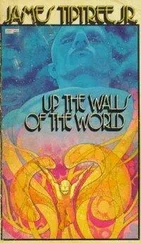I feel more at ease — or at least less ostracized — upon coming to a major avenue. Within sight is an ostentatious lounge complete with Christmas lights and tinted windows. Unfortunately, the bathroom is home only to blank walls and the imperious scent of urinal cakes and stale piss. Mona, the bartender, offers me a glass of water when I emerge. She says I look like I could use a drink, which I decline, though I do tip her for the water. Her hands are more callused than wrinkled, her hair is more orange than red. She's the geriatric Raggedy Anne, complete with a voice about as crisp as a 78 from the 1910s and a body that appears to have spent numerous years on some planet with a mass about ten times that of the Earth. It looks like her belt-buckle is moving, but then I realize that there is a second protrusion floating pendulously just above her waistline. I don't stare; I simply notice.
Mona preemptively apologizes for the behavior of the drunken day laborer sitting at the end of the bar. He is an icon of sorts, the final installment in Mexico's peasant progeny: born in some place down south that has what seems to be too many 'q's and 'x's in its name, a former worker at a Juarez maquiladora up here to make enough money to return home one day, only the concept of home changes, and Mexico becomes like the Israel of Medieval rabbis, and identity ceases to be easily defined by a line so easily discernible on paper — even if it stumbles upon land — and suddenly it's ten years later and there's debt and a wife and unanticipated kids to feed and still the desire, though somewhat diminished, to return once enough money has been saved. And yet here he is: drunk at three in the afternoon. He offers no excuses for his state. Chingada is his mantra. Traditional Mexican music blasts from a jukebox painted in those “electric” hues that were so popular back in the late-eighties and early-nineties. It's like a prop out of Saved by the Bell .
I tell Mona about my search for Coprolalia. She nods very politely. “I wonder if he knows the Bay Ridge guy.”
“What Bay Ridge guy?”
“Well, this was fifteen years ago, maybe. I used to work in this place down on Third Avenue. It was a real hole-in-the-wall. Lotta regulars. Lotta fights. But every once in a while we'd get someone new, and I'd always make sure they got the royal treatment. That's how you get regulars, after all. He was this little guy, couldn'ta been older than eighteen. I know what you're thinking. But you gotta understand that things were a lot lenienter back in those days. Long as you had an ID to show me, it didn't really matter. It wasn't until later that I found out he was something of a legend—'specially among the art crowd in Manhattan.”
“Why?”
“Oh, he drew something on the stall like the guy you're looking for. And he was such a nice, little Jewish boy. He was from around here.” She provides no further information besides one thing: big ears.
I leave the bar and begin to make my way down Avenue J. The area is not dominated by the gelid stares of before, perhaps because there is a paucity of balconies from which to scowl. Like Boro Park, the previous neighborhood, this area is predominately Orthodox Jewish, and consequently lacking in establishments that cater to drinkers. The only place on Sean's list in relatively close proximity is a bit south on Coney Island Avenue. I decide to go there, as it seems that I have pissed away the past two hours with nothing to show for it except for a guilty conscience as a consequence of my intact foreskin.
The establishment on Sean's list is a pizza place with a bar. Contractors from Sheepshead Bay are busting the balls of the bartender. Some would call him a hipster; some would call him ostensibly collegiate (perhaps not some — just me). Bob Seger bemoans the trials of the road. A few old timers watch the Yankees game from a booth. Two out of this crew sport Brooklyn Dodgers hats. The waitress is in her early twenties, but she already knows everyone here. She is a paragon of sorts, a necessary feature in any drama that panders to women for whom the theme of suffocation is easily relatable. She seems less than surprised when I ask to see the bathroom.
“You from En Why You, too?” she asks.
“Excuse me?”
“That professa' guy was here a while back. You wit' him?'
“Which professor?”
“Hey, Pauly,” she shouts to the kitchen. A man coated in thick, black hair on every portion of his body except, perhaps, his forehead, cheeks, and pate, sticks his head around the corner. “What was 'at professa's name?”
“What professa'?”
“That guy from En Why You.”
“Shawn something.” He pauses to think. “Guy was a real fuckin' D-bag,” he concludes before receding out of sight.
“You know a professa' Shawn?”
“Yeah,” I respond hesitantly.
She takes on a patronizing countenance. “Does he like to look in shitters around the city?”
“Language!” an older woman calls from a nondescript location. “Language, Chrissy, language.”
“Sorry ma',” reluctantly. “Does he explore bathrooms around the city?”
“She just gaught into Brooklyn Law,” the mother says over the noise of her heels clicking against the tile, a sound not unlike a chicken pecking concrete.
“Ma',” she rues.
The woman is by my side quickly. “Not that you'd ever know,” she says with a contemptuous shrug and a slight raise of one arm into teapot handle position. The other arm soon forms the spout. “She taughks like a fuckin' sailor.”
It's difficult to tell if the accent is of the Brooklyn, Staten Island, or Jersey variety. It's kind of an amalgam of all three, which, I've heard, is the dialect spoken around Gravesend, a community that became famous for opening its arms to New Amsterdam's first prostitute, Griet Reyniers, after she and her not-so-white husband were driven from Manhattan. This is not to say that Gravesend is particularly famous for its diversity or its prostitutes — just the one.
“You here to see my son's murreal?”
“Your son's mural?”
“Yeah,” Chrissy begins, “He painted something downstairs.”
I admit that I am skeptical. I can't see these two being the mother and sister of Coprolalia. Perhaps skeptical is the wrong word. Rather, I lack optimism. I guess this means I'm being pessimistic.
“Yeah, my brotha' Mark did that before he turned into a fuckin' addict.” The mother glares. “What? He's a fuckin' dope fiend, ma'.”
She expounds upon the tragic fall of Mark, an aspiring guitarist influenced by Slayer, Pantera, and other bands with equally menacing names. “Ya' know that sawng Cemetery Gates ? Yeah, he used to be able to play it note-for-fuck-ing-note.” Apparently that shooting star landed somewhere in North Jersey, where he now spends his time avoiding debt collectors and the intractable face of reality with a girlfriend whom the family calls “Train Wreck.” Her body type is described as lumpy. She wears a lot of dresses, which evidently brings to mind two badgers fighting in a pillowcase.
Chrissy escorts me down the stairs. She asks about the search, which, I admit, has not been going well. “Who gives a shit about this type of shit anyways?” she asks as I begin to examine the mural, which must be over a decade old. “It's just some stupid murreal.”
“You'd be surprised,” I respond as I continue to examine the street scene that has been painted on the wall of the lobby where one waits for the bathroom. It's clearly not the work of Coprolalia. He does not create landscapes, and, so far as I know, he does not work with paint on this grand of a scale. Her brother certainly has talent, I tell her, but he's definitely not Coprolalia.
“Well shit, I coulda' told ya' that. The Coprolalia's in the can,” she says as she kicks open the door.
Читать дальше










